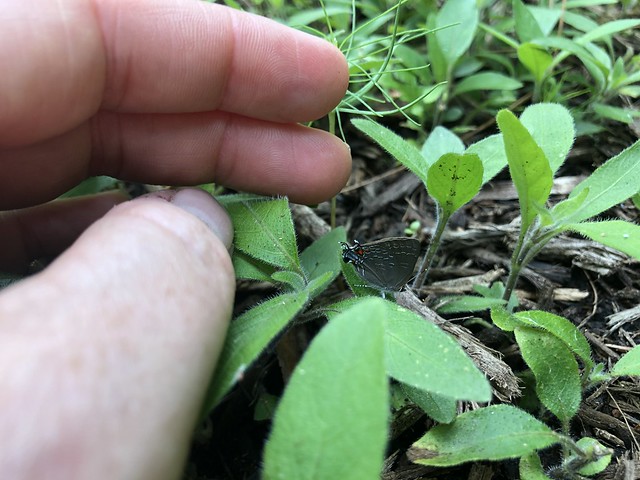Banded Hairstreak | Satyrium calanus

This is a video. Give it a few seconds to load…read and come back.
Yesterday morning I finished doing the major weeding to one of our beds. It was the last bed that needed to be done and now everything is really on a maintenance mode—which means, continue going through and picking out the cherry laurel, elm, and pine seedlings that will germinate over the course of the next month or two. It’s never ending!
As I was removing little strands of basket grass I noticed something drop down and land on the Carolina ruellia. I looked over and it was a tiny butterfly and incredibly docile. I stopped pulling weeds and focused in on the butterfly. At first I thought it was a typical gray hairstreak but then it was really too tiny for that. Plus the markings didn’t seem right. Since the butterfly was being very still I ran inside to grab my phone. Normally I would have grabbed my dSLR but I didn’t want to waste time switching to the macro lens and my new iPhone takes decent macro photos so I went with that.
The butterfly was still in the same spot and that made me believe that it had just eclosed that morning. I wasn’t sure what the chrysalis looked like so I didn’t bother trying to find it and instead went into butterfly paparazzi mode. Hairstreaks are notorious for skittering off before you can get a good photo and I wanted to get as many photos as possible before this one decided it was ready to take flight.
After I had my fill I tried putting the photo into my iNaturalist app via my phone. I am not super fond of the phone app (I’m planning an iNaturalist post soon) but it works in many instances. This instance I really wanted to be able to compare my butterfly with photos and it just wasn’t going to work well in the app. I grabbed my butterfly book and flipped to the hairstreaks and voila, a banded hairstreak!
It turns out that we are really on the fringe of their range, which is primarily in the the northeast and a smaller cluster in the southern Appalachians and a sprinkling in Texas and the mid-west. Caterpillar host plants include oaks, hickories, and walnuts. Definitely a surprise find in the yard! I’ll be on the lookout for more now!
I checked on it a few more times as Chris and I worked to fix the rock edging in the garden from when we had work done on the well a few weeks ago and an hour later the butterfly had finally flown away.









One Comment
shoreacres
Well. And here I thought all little gray hairstreaks were gray hairstreaks. I’m going to have to take a better look at my photos! Cool that you had such a cooperative subject!